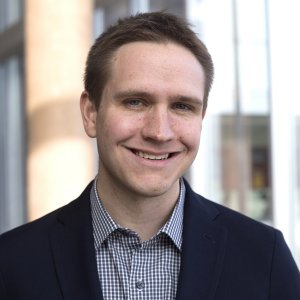Presented By: Aerospace Engineering
AE585 Graduate Seminar Series - Dealing with a Little Turbulence on the Trip out to Mars
Dr. Benjamin Jorns, Assistant Professor Aerospace Engineering, University of Michigan

Dr. Benjamin Jorns, Assistant Professor Aerospace Engineering, University of Michigan
High power electric propulsion (EP) thrusters are an enabling technology for the next generation of deep-space exploration. The high specific impulse of these systems translates to substantial savings in cost when compared to spacecraft that employ traditional chemical rockets.
This cost savings comes with the caveat, however, that EP systems inherently have low thrust. In order to perform orbital transfers, they therefore must operate continuously for years---accelerating the spacecraft to its destination very gradually. This requirement poses a unique challenge as to how to certify thruster lifetime for long-duration, deep-space missions. While one potential and attractive solution to this problem is to perform qualification through analysis, developing the numerical tools required for this technique has proved to be intractable to date. This is because there are key aspects of the fundamental operation of these systems that we do not sufficiently understand to model them. Most notably, for the EP system baselined for most deep space missions, the Hall thruster, there are a number of open questions about what governs a critical aspect of its operation---the electron dynamics in its exhaust. This talk focuses on a theoretical description of how the onset of low-level plasma turbulence might be the dominant contributor to the electron dynamics in the Hall thruster and provides an overview of experimental work to date that has been done at the University of Michigan to address the underlying questions concerning this process. The implications of this work are discussed in the context of developing testing and modeling methods for future mission applications.
About the speaker...
Dr. Benjamin Jorns is an assistant professor in the Department of Aerospace Engineering at the University of Michigan and co-director of the Plasmadynamics and Electric Propulsion Laboratory (PEPL). Prior to joining PEPL, Dr. Jorns was a member of the electric propulsion group at the NASA Jet Propulsion Laboratory (JPL) in Pasadena, California where his work combined experimental and analytical techniques to investigate propulsion systems for the next generation of NASA robotic missions. Dr. Jorns also held a lecturer appointment in the Mechanical and Aerospace Engineering Department at UCLA from 2013-2015. His primary research interests include wear mechanisms and stability in electric propulsion systems, turbulence and nonlinear processes in low-temperature plasmas, developing new plasma diagnostics, and investigating breakthrough forms of in-space propulsion. He has experience with several commercial and government-build plasma propulsion systems including high-current hollow cathodes, 1-10 kW class Hall thrusters, and low-TRL electrodeless thruster concepts. His work with electric propulsion technology has centered on developing first-principles understanding of their operating principles as well as implementing time-resolved and laser-based diagnostics to characterize behavior.
High power electric propulsion (EP) thrusters are an enabling technology for the next generation of deep-space exploration. The high specific impulse of these systems translates to substantial savings in cost when compared to spacecraft that employ traditional chemical rockets.
This cost savings comes with the caveat, however, that EP systems inherently have low thrust. In order to perform orbital transfers, they therefore must operate continuously for years---accelerating the spacecraft to its destination very gradually. This requirement poses a unique challenge as to how to certify thruster lifetime for long-duration, deep-space missions. While one potential and attractive solution to this problem is to perform qualification through analysis, developing the numerical tools required for this technique has proved to be intractable to date. This is because there are key aspects of the fundamental operation of these systems that we do not sufficiently understand to model them. Most notably, for the EP system baselined for most deep space missions, the Hall thruster, there are a number of open questions about what governs a critical aspect of its operation---the electron dynamics in its exhaust. This talk focuses on a theoretical description of how the onset of low-level plasma turbulence might be the dominant contributor to the electron dynamics in the Hall thruster and provides an overview of experimental work to date that has been done at the University of Michigan to address the underlying questions concerning this process. The implications of this work are discussed in the context of developing testing and modeling methods for future mission applications.
About the speaker...
Dr. Benjamin Jorns is an assistant professor in the Department of Aerospace Engineering at the University of Michigan and co-director of the Plasmadynamics and Electric Propulsion Laboratory (PEPL). Prior to joining PEPL, Dr. Jorns was a member of the electric propulsion group at the NASA Jet Propulsion Laboratory (JPL) in Pasadena, California where his work combined experimental and analytical techniques to investigate propulsion systems for the next generation of NASA robotic missions. Dr. Jorns also held a lecturer appointment in the Mechanical and Aerospace Engineering Department at UCLA from 2013-2015. His primary research interests include wear mechanisms and stability in electric propulsion systems, turbulence and nonlinear processes in low-temperature plasmas, developing new plasma diagnostics, and investigating breakthrough forms of in-space propulsion. He has experience with several commercial and government-build plasma propulsion systems including high-current hollow cathodes, 1-10 kW class Hall thrusters, and low-TRL electrodeless thruster concepts. His work with electric propulsion technology has centered on developing first-principles understanding of their operating principles as well as implementing time-resolved and laser-based diagnostics to characterize behavior.